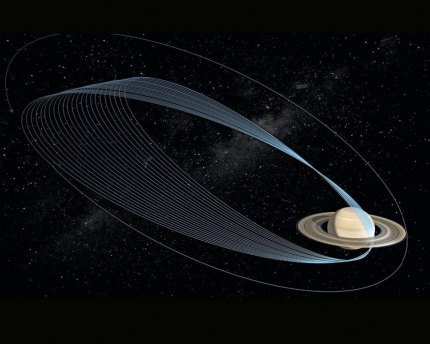Video:
Cassini to go where no spacecraft has gone

The Cassini spacecraft will offer a close-in view of Saturn.
Artist's concept: Erick Sturm, NASA/ Jet Propulsion Laboratory-Caltech.
At a televised briefing today, scientists described the spectacular ending they have planned, aimed at milking the mission for scientific information about the planet -- down to the final seconds before the spacecraft comes apart and melts while plunging into Saturn’s murk Sept. 15.
“We are going to dive into the gap between the rings of Saturn and Saturn’s atmosphere,” said Earl Maize, Cassini project manager at NASA’s Jet Propulsion Laboratory in California. It is “a place no spacecraft has ever gone. We’re going to be going 70,000 miles per hour into a 1,200 mile-wide gap. …Even a piece of sand at that velocity will take out one of our instruments, or, if it’s in the wrong place, could cripple the spacecraft.”
While it is a dangerous maneuver, it is also true that the spacecraft is running out of propellant. And by controlling the spacecraft's crash, the scientists will avoid contact with a Saturn moon, Enceladus, that may harbor life.
“Enceladus has got a warm undersea ocean,” Maize explained, “and it’s got plumes coming up. We cannot risk inadvertent contact with that pristine body. Cassini has got to be put safely away. …The only choice was to destroy it in some controlled fashion.”
The spacecraft was named for the scientist Giovanni Cassini, who, in 1676, observed a division in the rings of Saturn. And during the two decades of the mission, social media users have come to associate the name "Cassini" with the spacecraft that delivers spectacular photos of Saturn. But for scientists, the Cassini mission has become a part of life.
When Linda Spilker, Cassini project scientist, started working on the mission, her daughter was in kindergarten. Now her daughter is married with a child of her own.
The mission was funded in 1989, the same year Joan Stupik, currently Cassini's guidance and control engineer, was born. Stupik was 8 years old when Cassini launched Oct. 15, 1997, from Cape Canaveral Air Force Station in Florida. The spacecraft arrived at Saturn on July 1, 2004.
And now, as Cassini prepares for its finale, Spilker speculated that the scientific findings from this last effort will be important. Scientists hope to:
- Understand the age of Saturn's rings.
- Examine the planet's north and south poles, as well as the planet's aurora.
- Measure the atmosphere.
- Use instruments to estimate the size of Saturn's rocky core. "Is it one Earth diameter in size? Two Earths? Smaller? We'll find out for the first time," Spilker says.
“Just a chapter," he added. "The book is not complete. There’s more to come. But this has been a marvelous ride.”
Related:
Researchers prep for spacecraft's grand finale
Follow StudyHall.Rocks on Twitter.
If you would like to comment, give us a shout, or like us on Facebook and tell us what you think.

